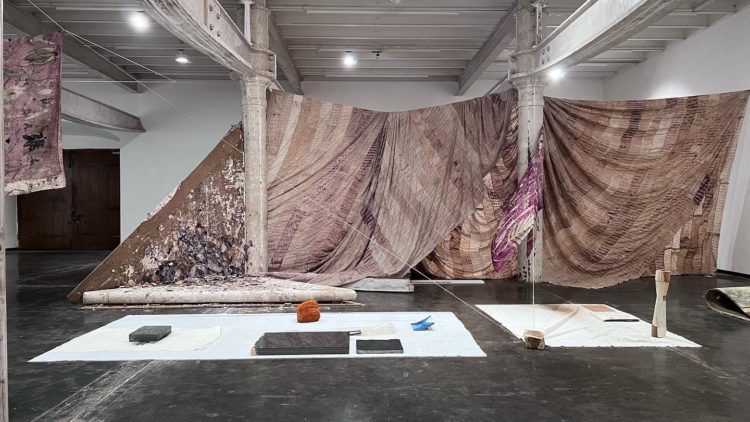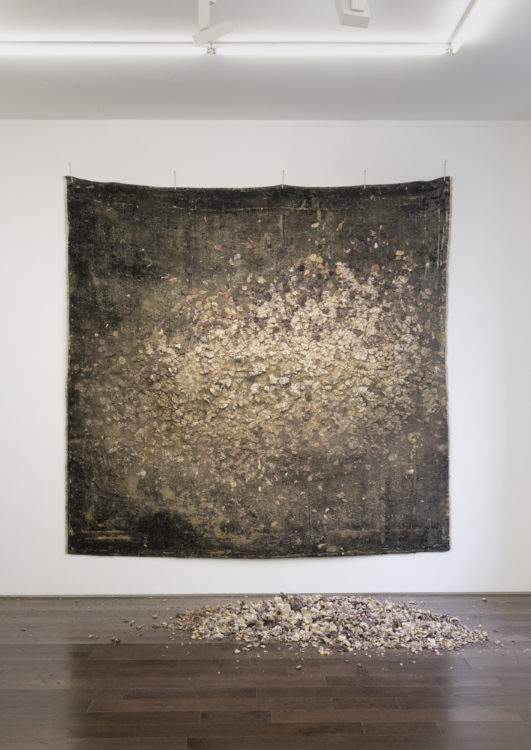Categories
- Amitesh Shrivastava
- Amol K Patil
- Anupam
- Ashwini Bhat
- Baptist Coelho
- Chirodeep Chaudhuri
- Desire Machine Collective
- Goutam Ghosh
- Hemali Bhuta
- Himali Singh Soin
- Huma Mulji
- Khageshwar Rout
- Khageswar Rout
- Mahesh Baliga
- Munem Wasif
- Neha Choksi
- Pallavi Paul
- Prajakta Potnis
- Prasad Shetty & Rupali Gupte
- Raqs Media Collective
- Risham Syed
- Rohini Devasher
- Sandeep Mukherjee
- Sarnath Banerjee
- Shreyas Karle
- Shumon
- Tejal Shah
- The Otolith Group
- Uncategorized
ParisLA: Hemali Bhuta– Learning/ Working
Hemali Bhuta in conversation with Dorothée Perret
ime. Decay. Dust. Spice. Textile… These are some of the materials encompassed in the work of artist Hemali Bhuta, who maneuvers sculptural arrangements in response to site-specific spaces with subtle grace—the four walls of a gallery or an open field in plain nature. With the exhibition Aha! at Project 88 in Mumbai (open through October 31), Bhuta continues a narrative that started about five years ago with Subarnarekha (La ligne d’or) (2017) at the Centre International d’Art et du Paysage de Vassivière, and continuing in New York with and the epic did not happen! (2021) at Galerie Ceysson & Bénétière.
As the curator Anne Couillaud, a close collaborator with the artist, voices in her new essay “About Love: An Offering”:
Three chapters—and their sensoria—are coming together in a single locus, closing a cycle in Mumbai after Vassivière and New York.
An artist that shuffles things, processes and timelines.
A consistent and uncompromising engagement with materials.
What is brought forth this time in the making, unmaking and remaking?
We are told most of the stories around gold and lac suggest death.
Lac-filled gold bangles…
The absence of visual narrative does not mean there is no narrative.
In my mind, I do know that they meet at some point. In the landscape, due to the landscape and also due to my encounters with the landscape and the people. — Hemali Bhuta1
By summoning these past works and fragments, and assembling them in this concise way, a sort of archive is constituted. Though, somehow, the gallery space becomes their place of revival and their repository at the same time… at least for a moment… One wonders if this chapter will be the works’ last stop…2

Anti-capitalist and feminist examinations
Dorothée Perret:
In the show and the epic did not happen! there is a sense of movement, yet the action itself is not rendered visible. With the work My pulse is beating and my veins throbbing and in wonder, my song bursts forth (2021) we see fallen parts of the piece exhibited on the wall—lac wax, dried leaves, dust—collected on the floor like refuse. A craziness fills my mind (2021) is a large piece of stitched together cloth you had hung from a two-story building in India, and then presented folded in multiple layers on the floor of the gallery. These actions suggest the work takes a certain time, shuffled places to be created and maybe not even finished. How are these invisible actions part of the work exhibited?
Hemali Bhuta:
Yes, time is a very crucial factor in working the works, in learning to learn. And as learning/working is a continuous activity, either working on something, with something, with someone, with the self, on the self and this is at all times in a given space and keeps shifting and making shifts as it /we traverse through different spaces. So much gets hidden and only so much gets revealed. Some things emerge and others fall out.
In the continuousness of time, there are moments of being held together, sometimes in love, in embrace, and other times in conflict, in war. These are feelings to be felt, invisibility is to be felt in what is made visible. The travel is to be felt.
To think of the feather as a material is to recognize that it has grown along with the body of the bird of which it was an integral part, mingling with the air in flight. In every case, by treating these erstwhile objects as materials, we rescue them from the cul-de-sac into which they had been cast and restore them to the currents of life.3

Are the adverse conditions and fragility found in the work a counterpoint—a method to escape the obvious mechanisms of art making?
Escape as a form of self-discovery. Rescue the making, the maker, and the made from the pressures and the fears of uncertainty, insecurity, and expectations most importantly.
Textile and soft fabrics recall craft traditions of weaving and sewing usually attributed to women’s work and domestic life. Yet the way you make subtle use of these political components transcends the value (market) and place (decoration) of the art object by offering possibilities of otherness and by leaving things unresolved. Can you talk about your interest in creating different paradigms and transforming historical narratives?
All work is domestic and everything domestic is work. This approach tries to resolve our understanding of many of the hierarchies of roles, status in the society thereby attempting to deflect the created value systems. We, at our S.O.I.L community center in Goa, are trying to shift these very paradigms of gender, of what education needs to be. Is it “about reading, writing, mathematics or is it for human flourishing, for peace and for happiness, where we can cultivate good inner qualities of compassion, love and patience. Only then we can bring about change.”4
I do refer to the narratives from the past and am conscious of what it means to be using, at times imitating, a particular gesture, a particular knowledge or practice in current times. I see it more as a pedagogical approach, to trace a path that others can follow but moreover make new pathways.
Thinking of a friend and Rainer Maria Rilke in Pathways:
Understand, I’ll slip quietly
Away from the noisy crowd
When I see the pale
Stars rising, blooming, over the oaks.
I’ll pursue solitary pathways
Through the pale twilit meadows,
With only this one dream:
You come too.
Read the entire article here: https://paris-la.com/2022/10/hemali-bhuta-learning-working/
